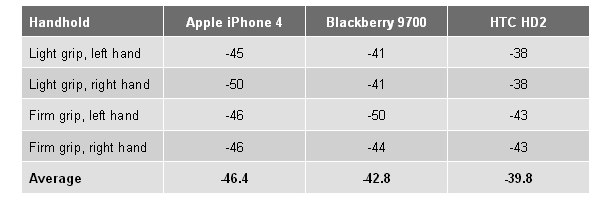Study: Death-grip antenna problems unique to iPhone 4

Yes, I realize it feels like we're beating a dead horse. And yes, I also realize that Apple has "fixed" that blasted iPhone 4 antenna problem by offering free bumper cases to iPhone 4 owners.
But UK-based PA Consulting Group has found that the antenna degradation problems caused by holding the iPhone 4 in the so-called "death grip" is a problem that's unique to the device. It also suggested that AT&T's weak signal may not be fully to blame for the iPhone's reception problem.
The firm's tests, which involved putting other smartphones through similar scenarios, found that the iPhone 4 performed "significantly worse" than its competitors. More importantly, it added that the iPhone 4's radio performance was already poor, operating at the lower end of the range and more likely to drop calls earlier than other phones. From the post:
In the case of the iPhone the grip avoided bridging the gap between the two antennas. When the “death grip” was used and the gap bridged, the signal level dropped to the point where it was not possible to conduct the test as the call could not be established to begin with. This effect was not seen when handling either of the other mobiles. Note that all these tests were conducted in a test chamber, calls with the iPhone could still be established outside the chamber even when using the “death grip."
The firm did find that placing a rubber band around the antenna, replicating the bumper case that wasn't yet available in the UK, significantly improved its performance.
The findings are important because, during an Apple press conference to discuss the problems, company CEO Steve Jobs went directly into a "it's not just us" presentation to show that smartphones in general suffer signal problems when held a certain way, a move that prompted the smartphone industry to fire back. And the firm did confirm that there was some signal degradation by the others when the devices were held in a certain way - but the others didn't suffer to the extent that a call couldn't even be placed. The iPhone 4 did.
It's also important to note that because the firm is UK-based, it suggests that the antenna problems and poor reception aren't just problems affecting U.S. customers on AT&T's network. These particular tests were conducted on the Vodafone network.
In the end, it still appears that the iPhone 4 represents a trade-off between a product that works effectively and one that looks pretty and has a lot of cool features.
Related coverage:
- Apple's Antennagate: A free iPhone 4 case doesn't "fix" the problem, does lower Apple's standards
- Jobs: “There is no Antennagate”
- How will ‘Antennagate’ affect Apple’s consumer perception?
- Poll: Has the antenna issue influenced your iPhone 4 purchase?
- Apple update: No recall coming; Company denies antenna warning was issued
- 54% say Apple should do a recall of iPhone 4
